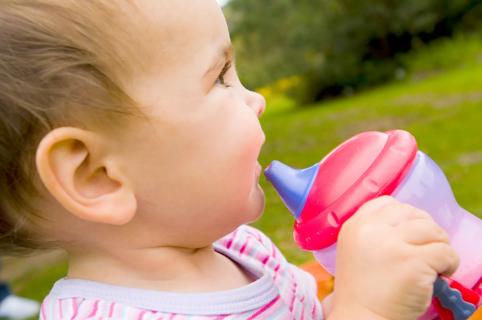A different formula may help babies with gas or other digestive problems — find out which one may be best for your baby.

Feeding your baby can be a special moment as you look into their eyes and they gaze back lovingly. But feeding time is less sweet when you’re worried about your child fussing or being in pain afterward. If your baby has bouts of gas, constipation or acid reflux after eating, it could be the formula.
Advertisement
Cleveland Clinic is a non-profit academic medical center. Advertising on our site helps support our mission. We do not endorse non-Cleveland Clinic products or services. Policy
The good news: There are a variety of formulas available, some specifically made for gassy babies or those with sensitive digestive systems. Pediatric dietitian Andrea Adler, RD, CSP, CSPCC, LD, discusses your formula options and when to consider trying something new.
A little spit-up or gas is perfectly normal and doesn’t mean you have to run out to the store for a different formula, reassures Adler. “All babies have some vomiting. Many are what I call ‘happy spitters.’ They have some formula or spit-up come out of their mouths, but it’s not shooting across the room,” she says. “If your child is gaining weight and growing well, the spit-up is no big deal. It might just mean a lot of laundry.”
However, consult with your pediatrician and discuss trying another formula if you see:
The formula aisle can be overwhelming with so many products to choose from. Here’s a breakdown to help you sort through your choices:
Infant formula is a mix of proteins, carbohydrates (sugars) and fats designed to resemble the composition of breast milk. Standard infant formula is based on cow’s milk but it’s not the same as drinking a glass of it.
Advertisement
Formula contains additional lactose (sugar that occurs naturally in milk), and the butterfat has been replaced with vegetable oils. For most families who use formula, it’s a great choice.
Some babies can’t tolerate typical formula. For them, a specialized formula that contains different proteins or carbohydrates may work better. These products are often labeled “may help with gas, fussiness or colic,” says Adler. Additional specialty formulas include:
If you’re considering changing formulas, speak with your pediatrician first. Your doctor can recommend which type of formula may work best for your baby’s symptoms.
For example, if your child has colic, your pediatrician may suggest a lactose-free formula first, says Adler. If your baby is arching their back after feeding, your doctor might choose an anti-reflux formula. Or you may even find out that your child’s symptoms are related to something other than the formula you’re using.
By law, all infant formulas, even generic or less expensive ones, must meet minimum nutritional requirements. But, recommends Adler, “I’d stick with the major formula companies rather than choosing generic. The well-known formula brands often contain other key nutrients that make it as similar to breast milk as possible, which may provide added benefits.”
If your doctor recommends switching formulas, don’t expect an overnight change in your baby, cautions Adler. It could take a few days to weeks to get the old formula out of your baby’s system.
“It’s not something that you want to try for just a couple of days and say, ‘This isn’t working. Let me try something else,’ unless the symptoms are getting worse with the new product. If that’s the case, then definitely stop feeding it to your baby,” she says. “But otherwise, remain patient. It may take a few weeks before you see an improvement.”
Advertisement
Once you’ve worked with your doctor to find a formula that’s right for your baby, the gas and discomfort should go away. And feeding time will once again be a time of happy, loving gazes.
Advertisement
Learn more about our editorial process.
Advertisement

In babies under 12 months old, cow’s milk has been associated with gastrointestinal bleeding

No juice until your child is 1 year old — and even then, they shouldn’t have much, if any

Ultimately, the choice depends on what works best for you and your baby, but it’s also important to be aware of the pros and cons of both

Ideally, you want your toddler to be drinking from a ‘big kid cup’ by age 2

Letting your baby feed themself foods the whole family enjoys has its benefits — but stick to softer foods and follow safe-eating guidelines

Levels are generally low, but there are ways to minimize potential health risks

Slowly introducing cow’s milk (or soy milk) can help your child make the change

In babies under 12 months, honey may cause a serious illness called infant botulism

The best parenting style balances enforcing rules and showing plenty of love

Tips include cutting back on sugar, focusing on exercise and managing stress

It can be harder to let go when you’ve invested time, energy and emotions — but it might be the healthier choice long term